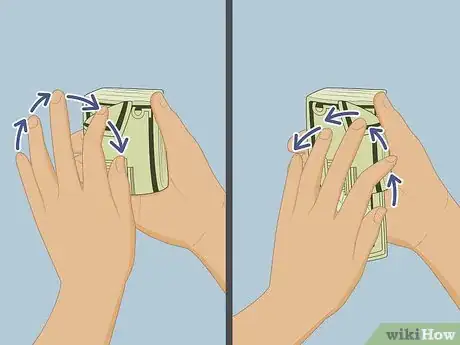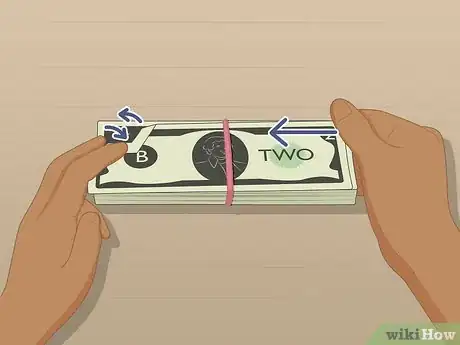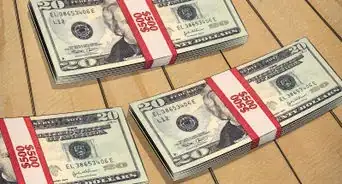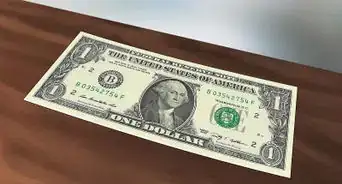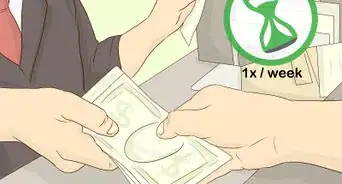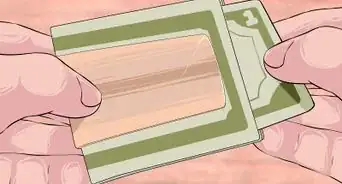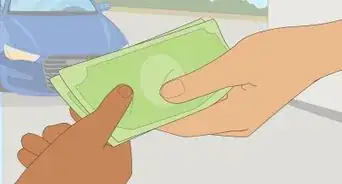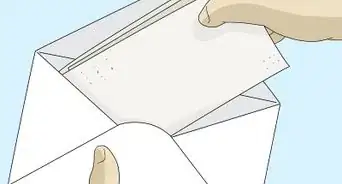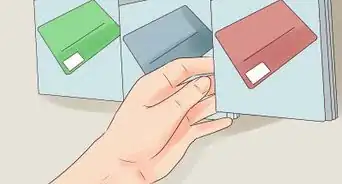This article was co-authored by wikiHow Staff. Our trained team of editors and researchers validate articles for accuracy and comprehensiveness. wikiHow's Content Management Team carefully monitors the work from our editorial staff to ensure that each article is backed by trusted research and meets our high quality standards.
There are 8 references cited in this article, which can be found at the bottom of the page.
This article has been viewed 114,130 times.
Learn more...
If you work at a casino or just want to learn a cool party trick, you may be wondering how to count money fast. Luckily, you can count more accurately and quickly by getting organized and sorting your bills and/or coins before you add up their total value. You can also try out a few different hand-holds in order to move bills quickly between your hands.
Steps
Sorting, Organizing, and Adding Bills Together
-
1Separate your stacks by denomination. For quick counting, the first thing you should do is create a stack of all of your 1s, all of your 5s, all of your 10s, all of your 20s, and so on. Gather all of your bills into one big stack and then go through it one bill at a time and put each one in the stack with its respective denomination.[1]
-
2Adjust the bills so that they’re all facing the same direction. Do this while or after you separate your bills into different stacks. This may make counting faster and easier, and also keeps your money more organized.[2]Advertisement
-
3Count each bill as you pass it from one hand to the other. Pick up one stack and hold it in your nondominant hand. Grab the top bill with your dominant thumb and pointer finger to make sure it’s only 1 bill. Then place the bill down on a flat surface in front of you while you count it. Continue to grab and move the bills one at a time while counting by the denomination.[3]
- For example, if you’re counting a stack of 5 dollar bills, think or say “5, 10, 15, 20,” as you grab and place the first 4 bills onto the flat surface.
-
4Wrap a rubber band around a stack once you reach 50 bills. Secure and set aside each stack of 50 bills of the same denomination. This is easy if you’re counting 1s, because you’ll just stop once you’ve reached 50. It’s helpful to know the monetary value of 50 of each denomination beforehand so that you know when to stop.[4]
- If you’re counting 5 dollar bills, stop when you get to $250.
- If you’re counting 10 dollar bills, stop when you get to $500.
- If you’re counting 20 dollar bills, stop when you get to $1,000.
-
5Add up all banded stacks and leftover bills. Continue banding each stack of 50 bills and setting them aside. Once you’re out of bills, add each stack together starting with the higher denominations and then add any leftover bills afterward.[5]
- It may be easier and faster to use a calculator at this point.
- For example, if you have 3 stacks of 20s, 2 stacks of 10s, 5 stacks of 5s and 23 loose 1 dollar bills, your math would look like this: 1,000 + 1,000 + 1,000 + 500 + 500 + 250 + 250 + 250 + 250 + 250 + 23 = 5,273.
Sorting, Organizing, and Adding Coins Together
-
1Separate the coins by denomination. Divide your pile of change into multiple piles that represent every denomination you have. For instance, you may have a pile of quarters, a pile of dimes, a pile of nickels, and a pile of pennies once you’re done sorting.[6]
-
2Count out a certain dollar amount and arrange it into a stack. In one pile, start counting as you make a stack of coins. Once you reach a dollar amount that’s easy to add and won’t cause your stack to tower too high, set it aside. The dollar amount will vary for each denomination.[7]
- For example, each stack of quarters may be worth $2 (8 coins) while each stack of pennies may only be worth $0.10 (10 coins).
-
3Make identical stacks out of the remaining coins. Using the initial stack as a model, make identical stacks out of the rest of the coins in that specific denomination pile. There’s no need to keep track of monetary value while you do this; just focus on creating stacks with the same exact number of coins as the first one.[8]
- If you have extra coins that don’t quite complete one stack, organize them into a stack and set them aside nearby.
-
4Add the stacks and extra coins together. Once you’ve made stacks out of all of the coins in a denomination, count them by their monetary value to add them together. Then, add on the value of the extra coins and write the total down.[9]
- For example, if you have 9 stacks of 8 quarters (worth $2), think or say, “2, 4 6, 8, 10, 12, 14, 16, 18” while you count the stacks. If you have 3 extra quarters, your math will look like this: $18.00 + $0.75 = $18.75.
-
5Add all denomination piles together. Once you’ve written a total for each denomination pile, add them up on a sheet of paper or by using a calculator. This is the total value of all of your coins.
- For example, if your quarter pile is worth $18.75, your dime pile is worth $11.60, your nickel pile is worth $3.15, and your penny pile is worth $1.33, then your math will look like this: $18.75 + $11.60 + $3.15 + $1.33 = $34.83.
Strategizing to Increase Speed by Hand
-
1Use your fingers to count in groups of 5. Hold a stack of bills that are all the same denomination in your hand folded in half vertically so that all 4 corners are facing down. Secure the folded stack on either side with your thumb and pointer finger. Then, count as you rotate using each of your fingers and your thumb from the other hand to strike down against the folded stack and unfold 1 bill at a time.[10]
- Pull down the 1st bill in the folded stack with your thumb, the 2nd with your pointer finger, the 3rd bill with your middle finger, the 4th with your ring finger, and the 5th with your pinky. Start again until you’ve pulled down and counted the whole stack.
-
2Pull each bill from your grip with your opposite thumb. Use your thumb to hold a stack of bills that have the same denomination folded vertically in one hand with the corners facing up. Hold the back of the stack on the other side with your opposite pointer finger. Then use your thumb on this same hand to press down on the front of the first bill and pull it out from underneath the other thumb’s grasp by swiping laterally. Count while swiping each bill this way.[11]
-
3Pass banded bills from one hand to the other. Wrap a rubber band around the middle of a stack of bills that share the same denomination. Place the stack horizontally on a flat surface in front of you. Place your left hand on the left side of the stack with only your pointer and middle fingers extended. Grab the stack by the top right corner with your right hand and slide your right thumb to the left to pass 1 bill over. Count as you alternate between using your left pointer and left middle finger to grab each bill.[12]
Community Q&A
-
QuestionWhen trying to slide a bill, my finger slips.
 DonaganTop AnswererTry using a rubber fingertip or a fingertip moisturizer, available in office-supply stores.
DonaganTop AnswererTry using a rubber fingertip or a fingertip moisturizer, available in office-supply stores.
References
- ↑ https://bizfluent.com/how-4995894-count-money-paper-bills.html
- ↑ https://bizfluent.com/how-4995894-count-money-paper-bills.html
- ↑ https://bizfluent.com/how-4995894-count-money-paper-bills.html
- ↑ https://bizfluent.com/how-4995894-count-money-paper-bills.html
- ↑ https://bizfluent.com/how-4995894-count-money-paper-bills.html
- ↑ https://www.youtube.com/watch?v=2pIAd4ewj1Y
- ↑ https://www.youtube.com/watch?v=C2sqCOFjD6c&feature=youtu.be&t=11s
- ↑ https://www.youtube.com/watch?v=C2sqCOFjD6c&feature=youtu.be&t=28s
- ↑ https://www.youtube.com/watch?v=C2sqCOFjD6c&feature=youtu.be&t=1m7s
About This Article
If you're looking for a fast way to count large stacks of money, start by sorting your bills in stacks of 1’s, 5’s, 10’s, and so on, then adjust the bills so they’re all facing the same direction. Next, pick up one stack and grab the top bill with your dominant thumb and pointer finger to make sure it’s only a single bill. Then, count the bills as you transfer them from one hand to the other, and wrap a rubber band around each stack of 50 bills of the same denomination. Finally, add up all the banded stacks and leftover bills to get the total value. For more tips, like how to quickly count coins, read on!










